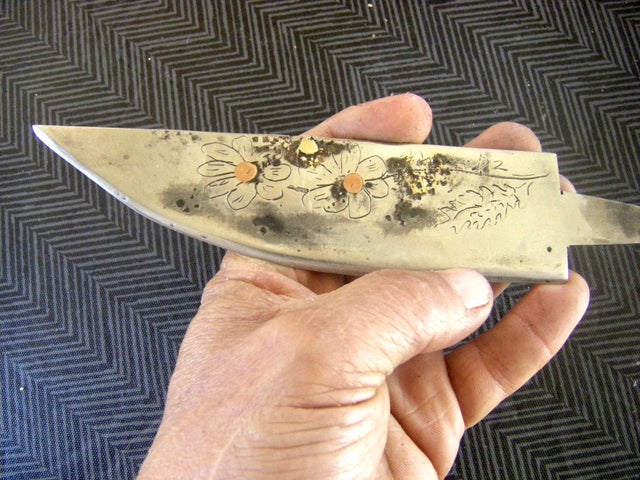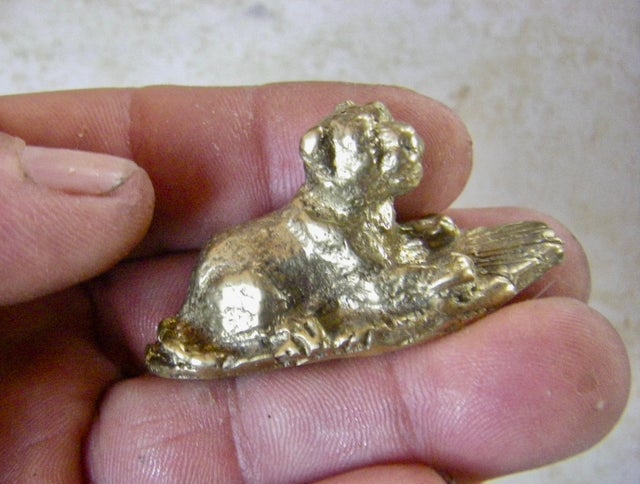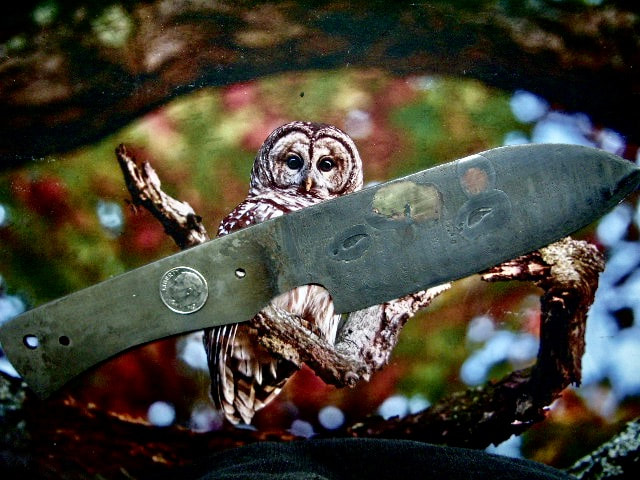- Knives
- >
- Knife blank blades
Custom blank blades by Miles scroll down
About my knife blades
Type of steels I have been making knives since the 1970's. I experimented with a lot of steel types, and heat treatments. I settled on two main types I prefer to work with, D2 semi stainless has chrome in it, so is amazingly tough, resists stains, has the qualities I like in a blade. My next choice is a high carbon 1084 to 1095 which gets the sharpest, hardest edge , but can be3 more fragile. My goal is to learn these two steels well. Heat treat
I 'edge harden' using a torch. More of an art then science. This means I do not needlessly stress the rest of the steel in the treatment, since only the edge needs to be hard, while the back can be softer for more toughness and flex. I harden blades one at a time as each blade requires for it's intended use. I have a special process that is proven in tests. I cryo deep cold treat all blades, known to improve toughness without sacrificing hardness. This is an extra step many blade makers leave out. The main test is universally referred to as,' the brass rod test.' I sharpen a blade to 600 grit so all blades begin the test evenly. Swipes are made on a brass rod as if trying to cut it. The test stops when the edge will no longer cut a sheet of paper without tearing. Factory knives such as buck and Gerber generally go 30 to 50 strokes. My minimum requirement to leave my shop is 200. Some as high as 400. I then put the edge of the blade on the brass rod, and beat it with a hammer till the blades cuts through. There can be no chip or dull spot. I then do a flex test in a vice. Usually 20 pounds is applied using a torque wrench. A flex of 10 degrees without hurting the blade. I then cryo deep cold treat all my blades. This improves some steel more then others, but in general adds to hardness without sacrificing toughness. The improvement is noticeable.
Etching I etch most of my steel with acid I mix up myself no longer able to acquire, but have a lifetime supply. Summing up the process, the blade is covered with thin hot wax. A design is scratched through this wax. Wherever the steel is exposed, the acid can eat the steel. A lifetime if using this acid has hurt the nerves in my hands. This acid fumes once killed every plant in the house. A nail dropped in this liquid bring it to rolling boil and the nail disappears in minutes. There is no substitute that eats steel like this 'secret concoction,' and is the basis of deep crisp etchings I get, few others can accomplish. Each blade is hand drawn, no templates used, one of kind designs not repeated. Each etching hand drawn unique to that blade. Since I do all the work myself I can keep my prices down.
Type of steels I have been making knives since the 1970's. I experimented with a lot of steel types, and heat treatments. I settled on two main types I prefer to work with, D2 semi stainless has chrome in it, so is amazingly tough, resists stains, has the qualities I like in a blade. My next choice is a high carbon 1084 to 1095 which gets the sharpest, hardest edge , but can be3 more fragile. My goal is to learn these two steels well. Heat treat
I 'edge harden' using a torch. More of an art then science. This means I do not needlessly stress the rest of the steel in the treatment, since only the edge needs to be hard, while the back can be softer for more toughness and flex. I harden blades one at a time as each blade requires for it's intended use. I have a special process that is proven in tests. I cryo deep cold treat all blades, known to improve toughness without sacrificing hardness. This is an extra step many blade makers leave out. The main test is universally referred to as,' the brass rod test.' I sharpen a blade to 600 grit so all blades begin the test evenly. Swipes are made on a brass rod as if trying to cut it. The test stops when the edge will no longer cut a sheet of paper without tearing. Factory knives such as buck and Gerber generally go 30 to 50 strokes. My minimum requirement to leave my shop is 200. Some as high as 400. I then put the edge of the blade on the brass rod, and beat it with a hammer till the blades cuts through. There can be no chip or dull spot. I then do a flex test in a vice. Usually 20 pounds is applied using a torque wrench. A flex of 10 degrees without hurting the blade. I then cryo deep cold treat all my blades. This improves some steel more then others, but in general adds to hardness without sacrificing toughness. The improvement is noticeable.
Etching I etch most of my steel with acid I mix up myself no longer able to acquire, but have a lifetime supply. Summing up the process, the blade is covered with thin hot wax. A design is scratched through this wax. Wherever the steel is exposed, the acid can eat the steel. A lifetime if using this acid has hurt the nerves in my hands. This acid fumes once killed every plant in the house. A nail dropped in this liquid bring it to rolling boil and the nail disappears in minutes. There is no substitute that eats steel like this 'secret concoction,' and is the basis of deep crisp etchings I get, few others can accomplish. Each blade is hand drawn, no templates used, one of kind designs not repeated. Each etching hand drawn unique to that blade. Since I do all the work myself I can keep my prices down.
Knife blank blades
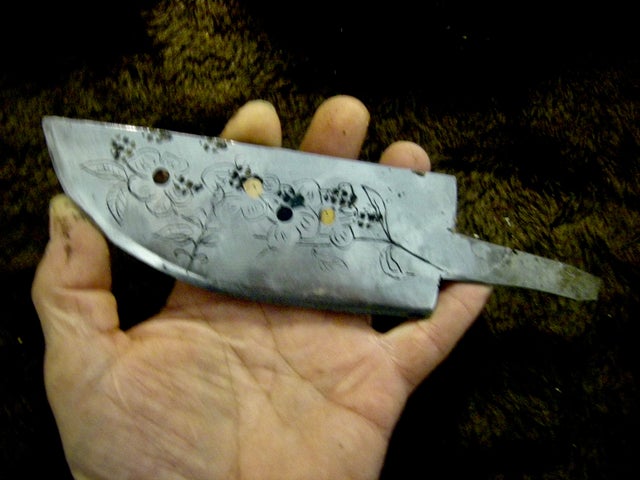
Blank custom knife blade Alaska skinner
$75.00
$75.00
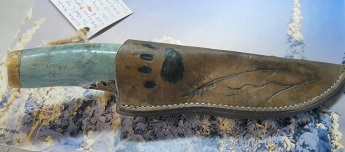
Knife sheath
$25.00
$25.00
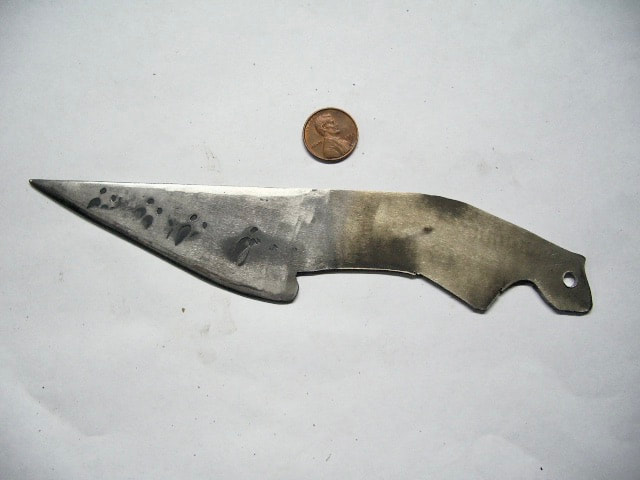
blank knife blade animal shaped
$78.00
$78.00
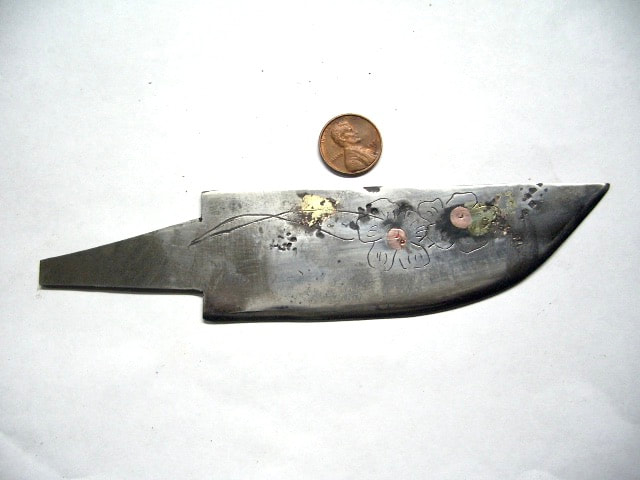
Blank knife blade etched
$79.00
$65.00

Blank knife blade hunter engraved
$63.00
$63.00

Meteorite blank knife blade
$250.00
$250.00

Blank knife blade animal tracks
$74.00
$74.00

Custom knife blank blade etched
$94.00
$94.00


